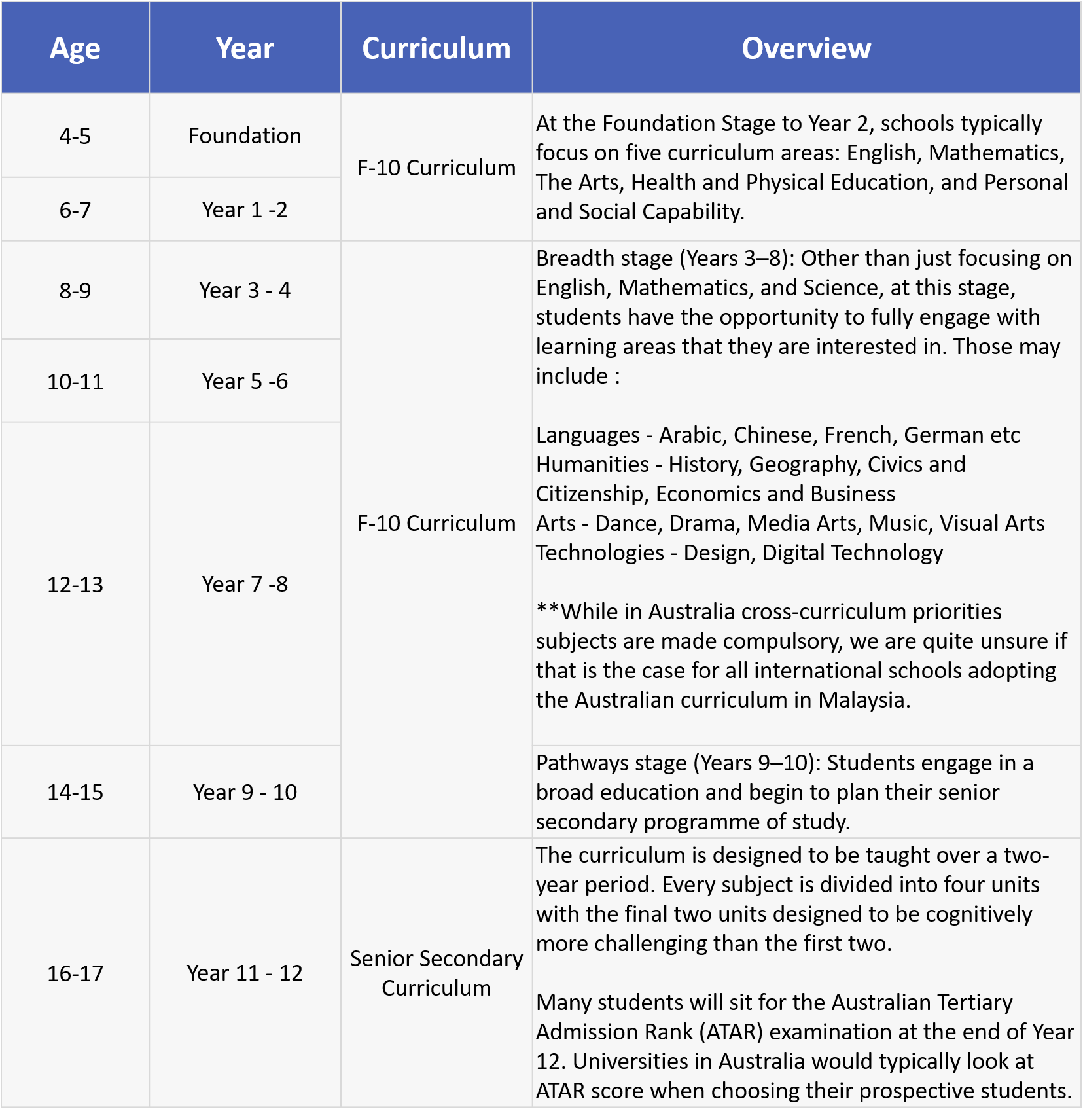While the establishment of international schools, in the beginning, was aimed to cater expatriate children, the growth of Malaysia’s middle class and the proliferation of international schools in this country has contributed to an augmentation of Malaysian students in these schools. In fact, when compared to other Southeast Asian countries, Malaysia boasts the highest number of students enrolled in international schools as reported in theStar.
In this article, we will be focusing on the British, American and Australian curriculums as these three are most typically implemented syllabus by international schools in Malaysia. Do read our Part 2 if you want to know more about the International Baccalaureate and Canadian Ontario Curriculum too!

British Curriculum
Known for its world-class examination quality, balanced syllabus, a multitude of extracurricular opportunities and high transferability, it is not hard to understand why more than a third of the world’s international schools opt for the National Curriculum for England, or the British Curriculum as their curriculum.
In essence, the curriculum can be categorised into four stages: foundation, primary, secondary, and pre-university. For those who are below 5 years old (i.e. preschoolers), they will be enrolled in the Foundation stage. At this level, the focus is on learning through play where they will be introduced to the fundamentals of literacy and numerals in a fun and entertaining way. As students move on to primary school (5-11 years old), they will be expanding their knowledge in language and maths, as well as learning other subjects like science, humanities, and arts. At this stage, the tests and examinations are still done internally (i.e. marked and assessed by the school teachers).
In secondary education (11-16 years old), students will learn subjects that will help them to get ready for their IGCSE. This examination is standardised worldwide and known as the world’s most popular international qualification for secondary schools. Upon the completion of IGCSE, students will have the option to further their education to pre-universities that offer courses like the A-Levels or International Baccalaureate.
Below are the breakdown of the stages and years for the British Curriculum :

Summary
| Pros | Cons |
|
|
Is it right for you?
One of the reasons why the majority of international schools in Malaysia and globally adopt the British curriculum, is that it caters to a broad range of student types. The IGCSEs also have a large range of subjects to choose from, allowing students to take what they excel in, hence with some hard work, almost all students can succeed in the British curriculum. If you’re sure that you want to pursue your degree abroad, or looking for a globally recognised pre-university qualification, or you prefer an academically-inclined and exam-oriented assessment rather than coursework, then A-Levels it the right choice for you!
Australian curriculum
Initially, the education system in Australia varies across states and territories. Nevertheless, in 2009, The Australian Curriculum, Assessment and Reporting Authority (ACARA) were established to develop and review the curriculum as well as the national assessment programmes for the Australian students. The new Australian curriculum is now divided into two main parts: F-10 (Foundation to Year 10) curriculum for primary school students and senior secondary curriculum for those in secondary schools. To learn more about how the children are assessed at each stage for every subject, you can download it here.
Below are the breakdown of the stages and years for the Australian Curriculum : 
Summary
| Pros | Cons |
|
|
Is it right for you?
Best suited for students who wish to study their tertiary education in Australia.
American Curriculum
Unlike the previous curriculums that we have looked at, the American system is different in the sense that it is highly decentralised. In fact, different states and even districts in the United State have a different education structure, all catered to the need of the community it serves. With this being said, the same is applied to international schools in Malaysia that adopt the American curriculum too. But rather than seeing these variations as a demerit, this actually gives American international schools in Malaysia (and the rest of the world) the liberty to select the best education available for their students.
Generally, the term ‘K-12’ is used to refer to the American education system covering from kindergarten (i.e. 5 years old) to the twelfth grade (i.e. 18 years old). The system is divided into three main stages namely elementary school (K-5th grade), middle school or junior high (6th to 8th grade), and high school (9th to 12th grade). In high school, the first year students will be called ‘freshman’, with second years being ‘sophomores’ and the final years being ‘seniors’.
In the elementary level, the focus is not just on ensuring that the students are able to grasp the basic of reading, writing, and simple maths. Attention is also given to activities that develop children’s socialisation, motor skills, and problem-solving abilities. Subjects like Science, Social Studies, Languages, and Arts will be introduced in different grades and given different emphasis depending on the curriculum chosen by the school. Although exceptionally rare, a student’s advancement to the next grade may be halted if he or she is found to not be able to hit a certain educational milestone.

Middle school was created initially to ease the transition from elementary to secondary education. In middle school, students are usually required to take a few core subjects such as English Language, Mathematics, Science, Social Studies, and Physical Education. They are also given more autonomy to choose their elective subject. While the selection of subjects to be taken by students are broad, often, students will opt for a stream or a group of selection that will prepare them with the foundation of the subjects that they might want to pursue in high school.
Moving on to high school, apart from the mandatory subjects that every student need to take, there are generally a broader array of subjects that a high school student can choose as their electives. High schoolers are typically expected to have a 7.5 contact hours per day and they need to successfully earn around 26 credits (i.e. completed courses) for them to be able to graduate with their high school diploma. Unlike the UK and Australian system where students sit for a final exam, students in American high schools are given students are given “grades” for all their courses. These grades are recorded and accumulated to provide a Grade Point Average (GPA). Should a student plan to pursue their undergraduate studies in the United States, they would usually need to take the Scholastic Aptitude Tests (SAT) or American College Tests (ACT) in their senior year.
Summary
| Pros | Cons |
|
|
Is it right for you?
The American curriculum is well suited to students who wants to learn about a broad range of subjects, not necessarily in depth. Students who do not perform well under stressful final year end exam conditions will also find it easier with the American curriculum.
It is very important to take note that different universities have different entry requirements, with more prestigious universities demanding for higher school credits, SAT and ACT scores for their admission. Hence, students with aims to go to better universities should really work harder to maintain good and consistent grades throughout their high school years. Whichever you choose, just remember to take a deep breath and consider all options based on our checklist given from our previous article “International School 101: Everything You Need to Know” before deciding!
To know more about the International Baccalaureate and the Canadian Ontario Curriculum, head to our Part 2 article!








